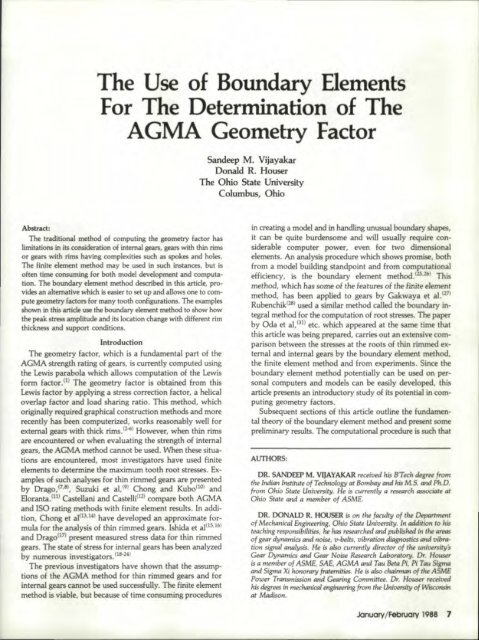Download PDF - Gear Technology magazine
Download PDF - Gear Technology magazine
Download PDF - Gear Technology magazine
You also want an ePaper? Increase the reach of your titles
YUMPU automatically turns print PDFs into web optimized ePapers that Google loves.
The Use of Boundary Elements<br />
FOlr The Determination olf'The'<br />
AGMA Geometry Factor<br />
Sandeep M. Vijayakar<br />
Donald R. Houser<br />
The Ohio Sta.te University<br />
Comumbus, Ohio<br />
Abstract:<br />
The Itraditional method 'of computing the geometry factor has<br />
limitations in its consideration of intemal gears. gears with thin rims<br />
or gears with rims having complexities such as,spokes and holes.<br />
The finite element method may be used in suchinstanees. but is<br />
often Ilime consuming for both modeJ development and computation.<br />
The boundary element meth.od described in this article, prov:ides<br />
an. alternative which. is easier to set up and allows one to compute<br />
geometry fa.Cl:ors fOf many 'loath oonfigur.ations ..The examples<br />
shown in this article use th boundazy ,element mthod 'to Showhow<br />
the peak stress amplitude and its location. change with diffel'ent rim<br />
thickness ands:upport conditions.<br />
Introduction<br />
The geometry factor, which is a fundamental part of the<br />
AGMA strength rating of gears, is currently computed using<br />
the Lewis parabola whi~h allows computation ofthe Lewis<br />
form. factorY' The geometry factor is obtained from this<br />
Lewis factor by applying a stress correction factor. a helical<br />
overlap factor and load sharing ratio. This method. which<br />
originallyrnquiredgraphical eonstructlon methods and more<br />
recently has been computerieed, works reasonably well for<br />
edema~ gears with 'thick .rims. l2 -6' However. when thin rims<br />
are encountered or when evaluaung the strength of internal<br />
gears, the AGMA method cannot be used. When these situations<br />
are encountered, most investigators have used finite<br />
'elements to determinethe maximum tooth root stresses. Examples<br />
of such .an,alyses for thin rimmed gears are presented<br />
by DragoP·8J, Suzuki et aV 9 ) Chong and Kubo!101 and<br />
Eloranta. (11) Castellani and Castelli(ll) comparie both AGMA<br />
and [SO r-ating methods with finite element results. In addition.<br />
Chonget 311113.141 have developed an approximate formula<br />
fo·r the analysis of thin rimmed gears. Ishida. et al(15.16)<br />
and Drago(17) present measured stress data for thin rimmed<br />
gears. The state of stress for in'temal. gears has been analysed<br />
by numerous investigators. (18-241<br />
The previous investigators have shown that the assumptions<br />
of the AGMA method for Ithin rimmed gears and for<br />
ilnt'emal gears cannot be, used successfully. The finjte element<br />
method is viable. but because of time consuming procedures<br />
in creating a model and in handling unusual boundary shapes.<br />
it can be quite burdensomand wil1 usually require considerable<br />
computer power. ,even fOIi two dimensional<br />
elements, An .analysis procedure which shows promise, bot:h<br />
from a model building standpoint and from ccmputanonal<br />
efficiency. is the boundary element method .IZS.lb 1 This<br />
method. which has some of th.e features of ,the finite ellement<br />
method. has been applied to gears by Gakwaya. et aL127)<br />
Rubench1k(28) used a similar method called the boundary integral<br />
method for the computation of root stresses. The paper<br />
by Odaet al, (31) etc. which appeared at the same time that<br />
this article was being prepared. carries out an extensive comparison<br />
between the stresses at the roots of 'thin rimmed external<br />
and internal gears by the boundary element method.<br />
the finite element method and from experiments. Since the<br />
boundary element method potentially can be used on personal<br />
computers and models can be easily developed. this<br />
article presents an introductory study of its potential in tompuhng<br />
geometry factors.<br />
Subsequent sections of this article outline the fundamental<br />
theory of the boundary element method and present some<br />
preliminary results. The computational procedure is such that<br />
At.rrHORS:<br />
DR. SANDEEP M. VQAYAKARreceived his BTech ,degree from<br />
the Indian Institute of <strong>Technology</strong> at Bomblzy and his M.S. and Ph.D'.<br />
from Ohio State University. He is curTe11tly a research associJ1te at<br />
Ohio State and II member of ASME.<br />
DR. DONALD R. HOUSER is on the faculty of the Depa11mmf<br />
of Mechanical Engineering, .ohio State Unitrersity .. In addition to his<br />
teaching responsibilities, he has researched and published 1M the areIU<br />
.of gear dynamics and' noise.IJ-b.elts., vibratio11' diagnostics and uibmrion<br />
.signaJ analysis. He is alSo currently director .01 the unwersitys<br />
<strong>Gear</strong> Dynamics and <strong>Gear</strong> Noise Research Laboratory. Dr. Houser<br />
is a member of AS ME. SAE, AGMA and Tau Beta Pi. Pi T!W Sigma<br />
and' Sigma. Xihonol"lVl/ fraternities. He is also duzinnanof the ASME<br />
Power Transmission I

















